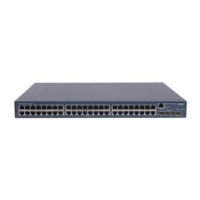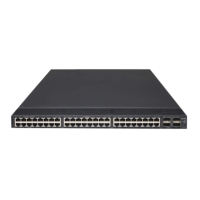3
Parameters
|: Filters command output by specifying a regular expression. For more information about regular
expressions, see CLI configuration in the Fundamentals Configuration Guide.
begin: Displays the first line that matches the specified regular expression and all lines that follow.
exclude: Displays all lines that do not match the specified regular expression.
include: Displays all lines that match the specified regular expression.
regular-expression: Specifies a regular expression, which is a case sensitive string of 1 to 256 characters.
Description
Use the display irf configuration command to display the pre-configurations of all IRF member switches.
The command displays the member ID, priority, IRF port state, and port information.
NOTE:
The pre-configurations take effect at the reboot of the switch.
Examples
# Display the pre-configurations of all IRF member switches.
<Sysname> display irf configuration
MemberID NewID IRF-Port1 IRF-Port2
1 1 disable Ten-GigabitEthernet1/1/2
2 2 Ten-GigabitEthernet2/2/1 disable
Table 2 display irf configuration command output description
Field Description
Switch Member ID.
New-ID The member ID configured for a switch after its reboot.
IRF-Port1
The left IRF port of a switch after its reboot.
• If it is displayed as x, it indicates that the IRF port is bound with the physical
IRF port x.
• If it is displayed as x.y, it indicates that the IRF port is aggregated from the
physical IRF ports x and y.
• If it is displayed as disable, it indicates that the IRF port is not enabled.
IRF-Port2
The right IRF port of a switch after its reboot.
• If it is displayed as x, it indicates that the IRF port is bound with the physical
IRF port x.
• If it is displayed as x.y, it indicates that the IRF port is aggregated from the
physical IRF ports x and y.
• If it is displayed as disable, it indicates that the IRF port is not enabled.
display irf topology
Syntax
display irf topology [ | { begin | exclude | include } regular-expression ]

